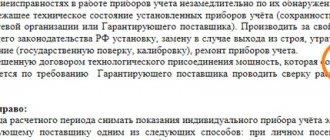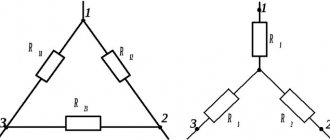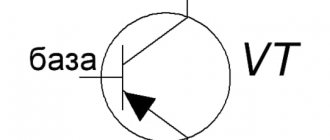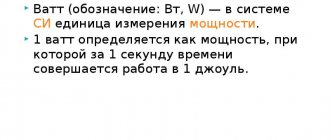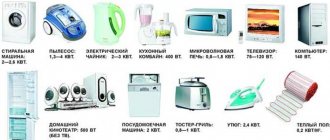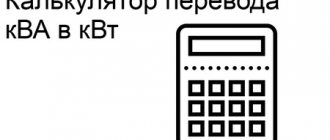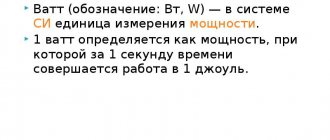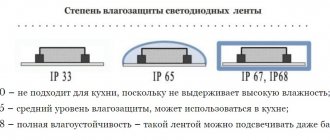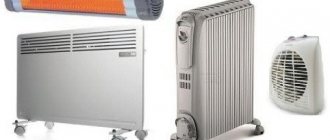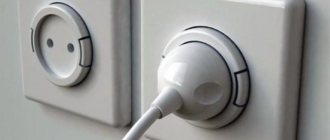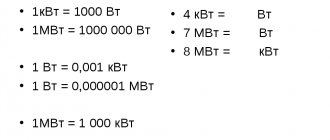Example
To convert the specified parameters of an electrical device from kW to W, it is necessary to clarify the information from the markings on the product body, or obtain data from the equipment passport developed by the manufacturer and included in the product package.
If it is determined that the power rating of an electric kettle is 2.2 kW, this means that in watts this value will be 2.2 x 1000 = 2200 W.
In some situations, it is necessary to determine the value of the total power characteristics of household consuming devices. This need may arise in the following cases:
- to select a sufficient cable diameter when installing electrical wiring;
- when choosing safety devices that disconnect the network if the parameters exceed permissible values;
- to ensure the correct layout of household equipment in the house and proper wiring.
The calculation is performed by summing the above indicators for each of the devices. After this, the obtained value is compared with that indicated as a control value in the characteristics of the cable or safety devices, and is taken into account when locating the equipment.
For the calculation to be correct, all values must first be converted into common units of measurement from watts to kilowatts or vice versa, using the previously described method.
Right choice
- The performance of heating devices should be 10% of the area of the room if its ceiling height is less than 3 m.
- If it is higher, then 30% is added.
- For the end room you need to add another 30%.
Necessary calculations
An example of heat transfer of an aluminum product.
After determining the heat losses, you need to determine the performance of the device (how many kW should be in a steel radiator or other devices).
- For example, you need to heat a room with an area of 15 m² and a ceiling height of 3 m.
- We find its volume: 15∙3=45 m³.
- The instructions say that to heat 1 m³ in the conditions of central Russia you need 41 W of thermal output.
- This means that we multiply the volume of the room by this figure: 45∙41=1845 W. The heating radiator must have this power.
Note! If the home is located in a region with severe winters, the resulting figure must be multiplied by 1.2 (heat loss coefficient). The final figure will be 2214 watts.
Number of ribs
Next, you need to calculate the number of sections in the battery. The instructions for the products indicate the parameter of each edge.
From it you will find out how many kW are in one section of a bimetallic radiator and an aluminum analogue - this is 150-200 W. Let's take the maximum parameter and divide the total required power in our example by it: 2214:200=11.07. This means that to heat the room you need a battery of 11 sections.
Wattmeter device
The power of household appliances simultaneously connected to the AC network should not exceed the permissible power of the network. Failure to comply with this condition can lead to overheating of the electrical wiring, failure of technical equipment, short circuit and fire in the room.
Power is determined using a special measuring device - a wattmeter. This device helps:
- control the operation of equipment,
- carry out testing of installations,
- keep track of energy consumption.
In a DC circuit, power is the product of current in amperes and voltage in volts, so no special equipment is required to determine this value.
In an alternating current circuit, power depends on three indicators: voltage, current and the phase shift between them. Therefore, wattmeters are used to determine power in AC networks.
Wattmeters are either analog or digital. Analog instruments can be recording or indicating. The indicator of the indicating wattmeter consists of a semicircular scale and a rotating arrow. The scale is calibrated according to power values in W. The operation of the device is based on the interaction of two inductors. The first, fixedly fixed, with a thick winding, a small number of turns and low resistance. This coil (1) is connected in series with the load (N). The second inductor is movable, with a large number of turns, made of thin copper conductor and high resistance. In the circuit, the coil (2) is connected in parallel to the load (H) together with an additional resistor (R) to prevent a short circuit between the inductances.
When taking measurements, the coils generate magnetic fields, the interaction of which leads to the formation of torque. The moving coil with the arrow deviates at a certain angle. The angle is equal to the product of current and voltage at the current time.
Wattmeter device diagram
Digital wattmeters determine reactive and active power. In addition, the digital screen of the device displays readings of voltage, current, and energy consumption per unit of time.
The operation of a digital wattmeter is based on a preliminary measurement of voltage and current. To do this, a current sensor is installed at the input of the device in series with the load, and a voltage sensor in parallel. The resulting instantaneous values are transmitted to the microcontroller, where the active and reactive components are calculated. The result is displayed on the display or attached external devices.
Watt concept
Watt (W) is a unit of electrical power - energy consumption over a certain time. 1 watt is equal to the same number of joules (J) of electricity for 1 second.
The name of this unit of measurement comes from the name of the British scientist James Watt, who first proposed using horsepower as a universal calculation for the technical performance of machines.
How many watts are there in a kilowatt?
Almost every person is familiar with the concept of electrical power. The passport of each electrical device must indicate the power it consumes. Even on an ordinary incandescent lamp, on a glass bulb, there is a mark: 40 W, 60 W, 100 W, etc. If you look at a washing machine or microwave oven, the figures are much higher - from 500 W to 2.5 kW.
The prefix “kilo”, as for other physical quantities, is used to indicate a multiple of a thousand - the numerical value of power, which is measured in kilowatts, must be multiplied by 1000 or the decimal point moved three digits to the right. Thus, we obtain an indicator of electrical power in watts.
Answering the question posed about how many watts are contained in a kilowatt, we can give a definite answer: one kilowatt equals 1000 watts. To consolidate and practically understand the translation process, consider several examples of recording electrical power:
- 0.75 kilowatts=750 W;
- 2.1 kilowatts=2100 W;
- 3.075 kilowatts=3075 watts.
Sometimes situations arise when you need to convert watts to kilowatts. Let us remember the relationship between these values: to translate, you need to move the decimal point three digits to the left or divide the value by 1000.
Examples:
- 2300 W = 2.3 kW;
- 50 W=0.05 kW;
- 249 W = 0.249 kW.
Convert how many amperes a kW has online. Calculator for converting current amperes to power watts
Power in an electrical circuit represents the energy consumed by a load from a source per unit time, indicating the rate at which it is consumed. Unit of measurement Watt
.
The current strength displays the amount of energy passed over a period of time, that is, it indicates the speed of passage. Measured in amperes
. And the voltage of electric current flow (potential difference between two points) is measured in volts. Current strength is directly proportional to voltage.
To independently calculate the Ampere / Watt or W / A ratio, you need to use the well-known Ohm's law. Power is numerically equal to the product of the current flowing through the load and the voltage applied to it. Determined by one of three equalities: P = I * U = R * I² = U²/R.
Therefore, to determine the power of the energy source when the current in the network is known, you need to use the formula: W (watts) = A (amps) x I (volts).
And to make the reverse conversion, you need to convert the power in watts to the current consumption in amperes: Watt / Volt.
When we are dealing with a 3-phase network, we will also have to take into account the coefficient of 1.73 for the current strength in each phase.
Total power in watts (kilowatts)
To correctly determine the cross-section of the electrical wiring cable and correctly select the rating of the network protective equipment, you need to calculate the total power of energy consumers. This value is obtained by adding the rated power of each consumer.
Important! Before adding up the consumer capacities, you need to convert them into the same unit of measurement: watt or kilowatt. Presumably the following consumers are connected to the network:
Presumably the following consumers are connected to the network:
- 5 lamps 100 W;
- 8 lamps 60 W;
- electric oven 2 kW;
- TV – 100 W;
- refrigerator – 0.3 kW;
- washing machine – 0.6 kW.
The power of lamps and TV is indicated in watts, and the power of ovens, refrigerators and washing machines is indicated in kilowatts. It is necessary to convert kilowatts to watts.
Considering how many watts there are in one kilowatt, we can write that the oven consumes 2 kW. Based on the fact that there are a thousand W in one kW, multiply 2 by 1000, you get 2000 W. The translation for a refrigerator is similar, the result is 300 W. Washing machine – 600 W.
Connection diagram for single-phase receivers
Next, add to 5 lamps 100 W each 8 lamps 60 W, 2000 W oven, 100 W TV, 300 W refrigerator, 600 W washing machine. You get a total figure of 500 W + 480 W + 2000 W + 100 W + 300 W + 600 W =3980 W = 3,980 kW. The result obtained is rounded up to give 4 kW.
Based on the resulting total value, the wire cross-section and automatic protective equipment are calculated.
Formula for three-phase network
Some private houses equipped with electric heating and electric stoves are supplied with a three-phase 380V line. There are two situations that require calculation in this network:
All loads are single-phase, divided into separate groups. The calculation is performed for each phase separately, similar to a single-phase network.
In addition to single-phase appliances and heaters, there are three-phase electric motors. For these devices, power is converted into current using special formulas:
and the current, respectively:
| Information! For rough calculations of the current of a three-phase electric motor, it is possible to use the formula I (A) = 2P (kW). |
Table on how to convert Amperes to Watts for calculating circuit breakers:
| Current of the Machine, Ampere | Voltage | |
| 220 volt | 380 Volt | |
| 1 | 0.22 kW | 0.38 kW |
| 2 | 0.44 kW | 1.31 kW |
| 3 | 0.66 kW | 1.97 kW |
| 4 | 0.88 kW | 2.63 kW |
| 5 | 1.1 kW | 3.29 kW |
| 6 | 1.32 kW | 3.94 kW |
| 8 | 1.76 kW | 5.26 kW |
| 10 | 2.2 kW | 6.57 kW |
| 13 | 2.86 kW | 8.55 kW |
| 16 | 3.52 kW | 10.52 kW |
| 20 | 4.4 kW | 13.15 kW |
| 25 | 5.5 kW | 16.44 kW |
| 32 | 7.04 kW | 21.04 kW |
| 40 | 8.8 kW | 26.30 kW |
| 50 | 11 kW | 32.87 kW |
| 63 | 13.86 kW | 41.42 kW |
| 80 | 17.6 kW | 52.59 kW |
| 100 | 22 kW | 65.74 kW |
Calculation of power in a DC network
The easiest way to convert amps to watts is for DC devices. In these devices it is used in its simplest form. In everyday life, such a calculation is most often made when repairing automotive electrical wiring and connecting LED strips.
These strips are connected to the power supply and to select it you need to know the current consumption of the LED devices. If the choice of unit is made incorrectly, it will be overloaded and burn out, or vice versa, the power of the device will be excessive. Such a block is more expensive and has larger dimensions.
On the housing of power supplies designed specifically for LED strips, the output voltage, current and power are indicated, but on some devices the power is not indicated.
In this case, it can be calculated using the formula P=U*I. For a device with an output voltage of 12V and a current of 1.4 A, P=12V*1.4A=16.8 W. Taking into account the 20% power reserve, such a power supply is enough to connect 1 meter of LED5050 strip.
You can do it differently and determine the current consumption of the LEDs. When installing a strip with a power of 14.4 W/m indicated on the tag, the current consumption of 1 meter will be I=P/U=14.4W/12V=1.2A. With a tape length L of 3 meters, the total current I=1.2 A*3m=3.6 A.
An example of converting Amperes to Watts in a single-phase network
Calculation for a single-phase network is most often carried out for household electrical wiring. Cosφ in this case is taken equal to 1, but difficulties arise due to the non-simultaneous inclusion of all electrical appliances.
For example, all kitchen outlets are connected to a 25A circuit breaker. These sockets include a 2kW electric kettle, 1.2kW electric oven, 0.8kW microwave oven, 3.5kW dishwasher and 3.5kW washing machine. Which of these devices can be turned on at the same time?
First of all, you need to find out the total power of the devices that can be connected to the machine. For this, the formula P=U*I=220V*25A=5500V=5.5 kW is used. As can be seen from the calculation, it is allowed to simultaneously turn on a kettle, oven and microwave without a dishwasher and washing machine, or one of these devices and one of the devices of lower power.
Converting Amperes to Watts for a three-phase network
Let's say you have a private house and use a three-phase input to connect it. A three-pole 32 Ampere circuit breaker is installed in the water shield. How much power is this? In order to convert amperes into watts in this case and find out what maximum power can be connected in this case, we will use the above formula (assuming that cos(φ) = 1):
P=380*32*1.73=21036 W ≈ 21 kW
Another example, if there is a three-phase input in the house and a 25A input circuit breaker, the total power of simultaneously switched on electrical appliances will be:
P=380*25*1.73=16500W=16.5kW.
Important! Such power can only be connected if the load is equally distributed across the phases.
The actual load in a residential building consists of a large number of electrical appliances of different power and is unevenly distributed.
Another example of how you can find the current for a three-phase motor when connected with a star:
Formulas for converting amperes to watts and vice versa are necessary primarily at home, but their knowledge will not be superfluous for electricians working in industrial enterprises.
Watt and kilowatt - what is it?
The watt is a measurement unit of power, as well as heat flux in physics, sound electrical energy flux, direct current power, active and apparent electric current power, radiation flux and ionizing radiation energy flux in the international measuring system. It is worth pointing out that this is a scalar measurement quantity, that is, measured and calculated.
Description from the reference book
To make it convenient to use watts, the international system has adopted the use of prefixes that determine the decimal multiple of the original indicator. As a rule, kilowatt is used for it. Translated from Greek, the prefix kilo means thousand. The use of a prefix means an increase in the original value by 103 times.
Note! KWh is a non-systemic unit of measurement that shows when energy is produced or consumed and in what quantity. It also shows mechanical work done and heat
Used to measure household electrical energy consumption or measure electrical energy production in the energy sector.
What is measured in these units
Megawatts are used to refer to large receivers or generators of electrical energy. The average coal power plant produces in the region of 600 MW.
Installed electrical capacity of the largest state district power plants in Russia in MW:
- Kostroma State District Power Plant, 3600;
- Ryazanskaya GRES, 3130;
- Konakovskaya GRES, 2520.
Megawatts are used not only to indicate the productivity of large energy facilities. A similar dimension is also common in the housing and communal services system and large industrial facilities. Thus, a high-rise multi-apartment residential complex is capable of consuming several MW of electricity to ensure the operation of lighting and air conditioning systems.
You may be interested in this Determination of polarity
An electric locomotive has the ability to consume up to 12 MW of electrical energy, and a single nuclear power plant can produce up to 1,200 MW or more. The largest nuclear power plant in Russia is Kursk NPP-2 - 1255 MW of one unit. Today in Russia, ten operating nuclear power plants use 35 power units with a capacity of more than 29,000.0 MW.
Total installed capacity of UES of Russia facilities
For your information! Due to concerns about the storage of nuclear waste and harmful emissions from coal-fired power plants, the global energy sector is currently expanding capacity to generate electricity from non-traditional sources using solar and wind. The unit capacity of such installations is more than 21,000 MW of solar energy.
A kilowatt is equal to 1000 watts. This dimension is used mainly to express the power consumption of electric motors, electric boilers, heaters and radio transmitters, household electrical appliances and water heaters.
Value watt-hour or kilowatt-hour
To take into account the consumption of electrical energy, a special device is installed at the entrance of the power cable into the room - an electric meter. Unlike electrical appliances, which are marked as W (W), the meter has a different abbreviation - kW⋅h (kWh), the full name of which is kilowatt-hour.
Counter
The power indicated on a household appliance is the amount of energy consumed in 1 hour. For example, a 2000 W oven for 2 hours of continuous operation, according to the meter readings, will consume 2000 * 2 = 4000 W = 4 kW.
In this way, the consumption of a household device is calculated over a period of continuous operation. If the consumer works intermittently, for example, a refrigerator, this value will be significantly less. Understanding how many watts household appliances consume in total, you can calculate the average consumption for a designated period of time. To calculate the amount to be paid for this period, the resulting value is multiplied by the cost of one kilowatt.
When calculating the volume of electricity consumed, concepts such as kilowatt-hour, watt-hour are used. This is the actual energy consumption of the device in watts or kW for a certain period of time in hours.
Technical specifications
When considering the design features of aluminum batteries, you need to consider:
- Center-to-center distance, which indicates the difference between the upper and lower collectors. For example, the power of aluminum heating radiators with a center distance of 500 mm is 183-190 W, which makes them the most attractive in the eyes of consumers, while a similar product with an indicator of 350 mm is only 139 W.
- The number of sections in a finished radiator may differ in different models, but most often manufacturers produce products equipped with ten elements.
- The manufacturing method of the aluminum radiator is also important. For example, cast sectional versions are in great demand due to their durability, and can even be installed in houses with central heating. Radiators made by extrusion are only suitable for autonomous heating, since their parts are connected by soldering, which is not as reliable as casting.
- It is important to consider what temperature aluminum radiators can withstand. As a rule, manufacturers most often indicate +90, and in some models even +110 - 120 degrees, while heating in the system itself rarely exceeds +70. This means that the power indicated by the manufacturer in the data sheet does not correspond to reality.
Each of the listed parameters is important in order to make correct calculations of their power and set the required number of sections.
Where is the power indicated (W and kW)
Manufacturers of electrical consumers indicate the rated power for each product. In this case, the receiver itself is marked, or the data is entered into the technical documentation accompanying it.
For large household consumers, for example, a TV, dishwasher, kitchen hood, the nominal value in W or kW is applied to the rear or front panel and duplicated in the technical documentation.
Markings on the kitchen hood
Marking of incandescent lamps (40 W, 60 W, 100 W, 150 W, 500 W) is applied to the glass bulb and cardboard packaging. The same indicator for an iron, hair dryer, or heater is indicated on their body.
Difference between kW and kWh
The concepts of kilowatt and kilowatt-hour indicated by an electric meter should not be combined. The latter term means not just power, but energy consumption. This takes into account the numerical indicator in kilowatts used during a certain time period.
For a lamp with a power (80 W) of 0.08 kW for 3 hours, the kilowatt-hour consumption will be:
0.08 x 3 = 0.24 kWh.
Understanding the method of converting watts to kilowatts or vice versa is not difficult. But correct calculation will allow solving important problems in determining the parameters of the home electrical network and ensuring the safe operation of household consumers.
The difference between kilowatt and kilowatt hour
In electrical engineering, a quantity called a kilowatt-hour is determined by electric meters. Due to the similarity of names, kilowatt-hours are sometimes confused with kilowatts. In fact, these are different parameters.
KWh is used to determine the amount of electrical energy produced or consumed per unit of time. For example, a receiver with a flow rate of 1 kWh determines the amount of energy consumed by a 1 kW device over 1 hour.
Unlike a kilowatt-hour, a kilowatt is a unit of power that characterizes the intensity of electricity consumption.
How kW and kW∙h are related can be seen using the example of a TV (200 W). The estimated viewing time of the television program was 1 hour. This could mean that the TV used 200 watts during this period. Multiplying 200 W by 1 hour, we get 200 W * 1 hour = 200 Wh = 0.2 kWh.
At the beginning of the electrification era, electricity was used only for indoor lighting. Those using this service understood that a 100 W light bulb would generate exactly 1 kW in 10 hours. With the beginning of the use of kW⋅h when calculating energy consumption, people began to better understand what they had to pay for. He now has the opportunity to regulate spending by properly selecting lighting equipment.
Not to be confused with kilowatt hour
Probably everyone has heard at least once in their life about such a unit as a kilowatt-hour (kWh). This unit measures the work done by the device per unit of time. In order to understand its difference from a kilowatt, let’s take the example of a home TV with a power consumption of 250 W. If you connect it to an electric meter and turn it on, then exactly an hour later the meter will show that the TV has consumed 0.25 kW of electricity. That is, the TV consumption is 0.25 kWh. A device with such a consumption value, left on for 4 hours, will “burn”, respectively, 1 kW of energy. The daily consumption of a particular device depends on the features of its design, and sometimes it may turn out that the devices that seem the least “gluttonous” to us actually make up a larger share of the total electricity costs. So, for example, a regular TV has 4 times lower consumption compared to a 100 W incandescent lamp. In turn, an electric kettle “burns” three times more light than such a light bulb. The average daily energy consumption of a personal computer is about 14 kW, and that of a refrigerator is up to 1.5 kW.
Watts to kilowatts
It is believed that 1 watt corresponds to the power required to do work (1 Joule) in 1 second.
The relationship between power (P), voltage (U) and current (I) is presented as a formula:
P = U ∙ I.
Knowing the voltage in the network and the power of the receiver, this formula is used to determine the current strength, select the wire cross-section and the rating of the power line protective equipment.
Electric discharge
Currently, to calculate how many watts per ampere or kV to convert to V, it is not necessary to do the calculations yourself. It is enough to type an online calculator into a search engine, for example, with a question about converting watts to amperes, and the address of the desired site will be given.
For convenience of calculations and notation, scientists introduced derivatives of W:
- Sub-multiple, less than Watts, used in medical equipment (for example, milliwatts, microwatts, nanowatts);
- Multiples greater than W are used in household electrical appliances (kilowatts) and in the energy field (for example, megawatts, gigawatts).
Converting these values from one to another is possible using an online converter.
The power of electrical appliances is expressed in watts and kW. For the convenience of calculations, it becomes necessary to reduce quantities to one number system. For example, watt needs to be converted to kW. How many watts are in a kilowatt? "Kilo" means that the number is a multiple of a thousand. It turns out that there are one thousand watts in one kW. To calculate how many kilowatts there are in a watt, you need to divide this number of watts by 1000.
An example of how to correctly convert W to kW:
- 1600 W = 1.6 kW;
- 40 W = 0.04 kW;
- 0.7 W = 0.0007 kW.
To find out how many kilowatts there will be in W, perform the opposite action - the value in kW is multiplied by 1000:
- 2.4 kW = 2400 W;
- 0.6 kW = 600 W;
- 11.8 kW = 11800 W.
Introduction to the topic of determining quantities
The generally accepted unit for measuring power is the watt (W). This parameter usually describes the rate of energy conversion or consumption. By definition, power is the ratio of work (energy expended) to the time it is performed. In turn, the unit of energy in the International System of Units (SI) has always been the Joule.
The value of “1 watt” in question corresponds to one Joule of work done in 1 second (J/s). For example, in electrical engineering there are special devices, wattmeters, that measure the power of an electric current or electromagnetic signal.
The unit received its name from the surname of the Scots-Irish inventor James Watt (Watt). This creator of the first steam engine first used it in describing the capabilities of a power machine. The watt was adopted in 1882 and largely replaced the traditional units of account that had existed before: foot-pound-force per minute and draft horsepower. The first unit of power corresponded to 2260 watts. As for the second, it is still used today: “metric horsepower” is approximately 735 watts.
As a unit named after a scientist, it follows the spelling rules originally adopted by the SI system. The name watt is written with a lowercase letter, and the designation W (W), including in the designation of non-system units, is written with a capital letter.
How to correctly convert these units
A watt is equal to a kilogram multiplied by square meters and divided by cubic seconds. The prefix kilo denotes multiplication by 1000. The same principle applies to power indicators, that is, 1 kW contains 1000 W and 1000 volts. This means that 1 unit = 0.001 subunits. That is, if you convert the power, then a 3 kW electrical appliance will be equal to 3000 W.
Conversion formula
In electricity
To simplify measurements in electricity, a subunit is used. You can find out how many watts are in a kilowatt and convert the units by multiplying watts by 103 and dividing by 1000. To carry out the reverse conversion, you need to multiply kW by 103 or multiply known indicators by 1000.
Quantities in electricity
Heat transfer of aluminum radiators: declared and real
Many years of experience in using aluminum batteries have shown that the parameters stated in product data sheets do not match the real numbers. This does not mean that manufacturers are lying, they just do not mention that these indicators are valid under ideal operating conditions, which, as a rule, does not happen in life.
For example, the heat transfer of aluminum radiators, which is indicated in the documents, may correspond to the truth if there is a difference of 70 degrees between the temperature of the air and the coolant. That is, the formula by which these parameters are calculated is as follows:
(treturn + tsupply): 2 – tair = 70 degrees
If the data sheet indicates the power of an aluminum radiator of 200 W at a temperature difference of 70 °C, then at room temperature +22 °C the calculations will be as follows:
(treturn +tfeed) = (22 + 70)x2 = +184 degrees.
Since according to GOST the difference in temperature in the supply and return should not exceed 20 degrees, their value can be calculated as follows:
The coolant temperature in the supply pipe is 184:2 +10 = 102 degrees.
In the return pipe it will correspond to 184:2 – 10 = 82 °C.
Based on these calculations, the aluminum radiator section will produce 200 W of heat, and the air in the room will warm up to +22 only if the coolant temperature is 102 degrees. This is unrealistic, since the maximum heating that modern boilers provide is 80-90 degrees, which means that the power of 200 W indicated in the data sheet does not correspond to the truth.
How to calculate your TV's electricity consumption
A TV is an essential element of household appliances in every home. Often, owners install several copies for each room. Devices can be of several types: cathode ray tube models, LED, LSD or plasma TVs. The power consumption of a device is affected by its type, screen size, color, brightness, white and black balance, active operation time, and duration of sleep mode. Based on the table of electricity consumption by household appliances, a TV uses an average of 0.1-0.3 kW.
Electrical energy consumption will depend on the type and operating mode of the TV.
The power of TVs in Watts with a cathode ray tube is 60-100 W per hour. On average he can work about 5 hours a day. Monthly consumption reaches 15 kW. This is how much electricity will be spent on its active operation. The TV also consumes 2-3 watts per hour in standby mode when plugged in. Total energy consumption can be 16.5-17.5 kW per month.
The energy consumption of LED or LSD models directly depends on the screen size. For example, an LSD TV with a 32-inch screen diagonal will consume 45-55 W per hour in operating mode, and 1 W in standby mode. The total electricity consumption per month is 6.7-9 kW. LED models consume on average 35-40% less electrical energy. In active mode, a 42-inch TV will use 80-100 W, in sleep mode - 0.3 W. Total consumption per month will be 15-20 kW.
Plasma TVs have good color reproduction. The TV power in kW is 0.15-0.19 in active mode, and 120 W/day in sleep mode. The total consumption per month can be 30-35 kW. To save energy, you should remove the plug from the socket, correctly adjust the brightness level depending on the time of day, and set the timer to automatically turn off.
What should you consider when performing power calculations?
Carrying out calculations regarding the power of heating batteries is an important matter that requires attention to detail. For example, it is not enough to calculate what heat output a heater must have in order to heat the room over its entire area. In this matter, you need to take into account factors such as:
- Method of connecting the battery to the heating network. If it is connected in a cross way, then the heat loss will be only 2%, while with the lower one they will increase to 13%, and with a single-pipe heating system - up to 20%.
- The region of residence should be taken into account, taking into account the period of the lowest temperatures of the year.
- Calculation of aluminum radiator sections based on heat loss is not possible without determining the quality of the building’s thermal insulation. If we take a private house as an example, we will have to take into account the following indicators in the calculations:
- The presence of a chimney “eats” 10% of the heat.
- Roofing brings losses by 20%.
- Non-insulated walls and windows - 30% each.
- The basement will take 10% of the heat.
Such losses can be reduced if you insulate the walls, make high-quality glazing and install heating in the attic and basement.
- If the window in the room faces north, then when calculating the power of the radiator and the number of its sections, you need to add 10% to the result.
- The location of the radiator or the use of the screen also affects the performance.
- You need to know exactly how much heating area is heated by one section of an aluminum radiator. This data can be obtained from the product data sheet.
Only by taking into account all the nuances can you make truly correct calculations of battery power. If some parameters are difficult to determine, then you should add 20-30% to the result and install a thermostat, which definitely won’t be superfluous.
